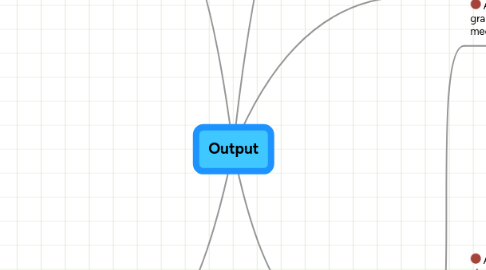
1. Display Devices
1.1. A display device visually conveys text, graphics, and video information
1.2. A monitor is packaged as a separate peripheral
1.3. Liquid crystal display (LCD) uses a liquid compound to present information on a display device
1.4. The quality of an LCD monitor or LCD screen depends primarily on
1.4.1. Resolution, Response time ,Brightness,Dot pitch, Contrast ratio
1.5. Resolution is the number of horizontal andvertical pixels in a display device
1.6. The graphics processing unit (GPU) controls the manipulation and display of graphics on a display device
1.7. LCD monitors use a digital signal and should plug into a DVI port, and HDMI port, or a DisplayPort
1.8. Plasma monitors are display devices that use gas plasma technology and offer screen sizes up to 150 inches
1.9. Televisions also are a good output device
1.10. Digital television (DTV) offers a crisper, higherquality output
1.11. HDTV is the most advanced form of digital television
1.12. A CRT monitor is a desktop monitor that contains a cathode-ray tube
2. Speakers, Headphones, and Earbuds
2.1. An audio output device produces music, speech, or other sounds
2.1.1. Most computer users attach speakers to their computers to Generate higher-quality sounds for playing games,Interact with multimedia presentations,Listen to music,View movies
2.1.2. Headphones are speakers that cover your head or are placed outside of the ear
2.1.3. Earbuds (also called earphones) rest inside the ear canal
2.1.4. Some speakers are specifically designed to play audio from a portable media player
2.1.5. Voice output occurs when you hear a person’s voice or when the computer talks to you through the speakers
2.1.5.1. Some Web sites dedicate themselves to providing voice output
2.1.5.2. Often works with voice input
2.1.5.3. VoIP uses voice output and voice input
3. What Is Output?
3.1. Output is data that has been processed into a useful form
3.2. An output device is any type of hardware component that conveys information to one or more people
4. Printers
4.1. A printer produces text and graphics on a physical medium
4.2. A nonimpact printer forms characters and graphics on a piece of paper without actuallystriking the paper
4.2.1. Ink-jet printers
4.2.1.1. An ink-jet printer forms characters and graphics by spraying tiny drops of liquid ink onto a piece of paper
4.2.2. Photo printers
4.2.2.1. A photo printer produces color photo-lab-quality pictures
4.2.3. Laser printers
4.2.3.1. A multifunction peripheral (MFP) is a single device that prints, scans, copies, and in some cases, faxes
4.2.4. Thermal printers
4.2.4.1. A thermal printer generates images by pushing electrically heated pins against the heat-sensitive paper
4.2.5. Mobile printers
4.2.5.1. A mobile printer is a small, lightweight battery-powered printer that allows a mobile user to print from a mobile device
4.2.6. Label and postage printers
4.2.6.1. A label printer is a small printer that prints on adhesive-type material
4.2.6.2. A postage printer prints postage stamps
4.2.7. Plotters
4.2.7.1. Plotters are used to produce high-quality drawings
4.2.8. Large format printers
4.2.8.1. Large-format printers create photo-realistic quality color prints on a larger scale
4.3. Impact printers form characters and graphics on a piece of paper by striking a mechanism against an inked ribbon that physically contacts the paper
4.3.1. A dot-matrix printer produces printed images when tiny wire pins on a print head mechanism strike an inked ribbon
4.3.2. A line printer prints an entire line at a time
5. Other Output Devices
5.1. Data projectors
5.1.1. A data projector is a device that takes the text and images displaying on a computer screen and projects them on a larger screen
5.2. Interactive whiteboards
5.2.1. An interactive whiteboard is a touch-sensitive device, resembling a dry-erase board, that displays the image on a connected computer screen
5.3. Force-feedback game controllers
5.3.1. Force-feedback sends resistance to the device in response to actions of the user
5.4. Tactile output
5.4.1. Tactile output provides the user with a physical response from the device
